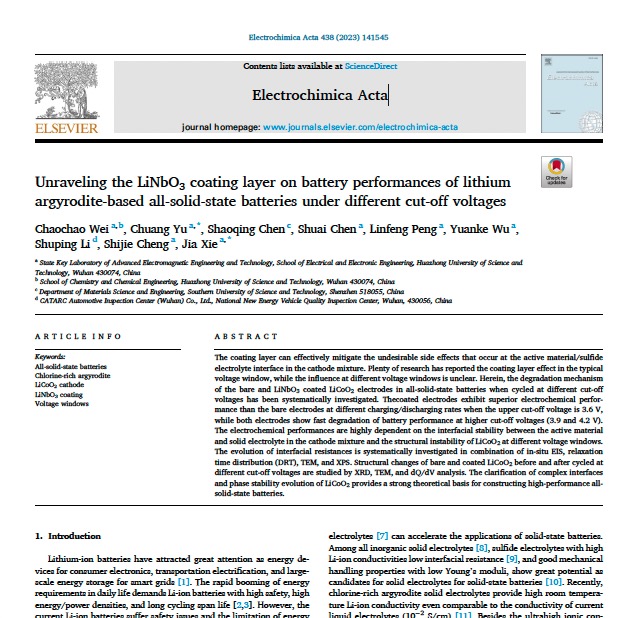
Indexed by: Journal paper
Journal: Electrochimica Acta
Included Journals: SCI
Affiliation of Author(s): 华中科技大学电气与电子工程学院
Place of Publication: 荷兰
Discipline: Engineering
First-Level Discipline: Material Science and Engineering
Document Type: J
Volume: 436
Page Number: 141545-141555
Key Words: All-solid-state batteries Chlorine-rich argyrodite LiCoO2 cathode LiNbO3 coating Voltage windows
DOI number: 10.1016/j.electacta.2022.141545
Date of Publication: 2022-12-26
Impact Factor: 7.336
Teaching and Research Group: 电力系
Abstract: The coating layer can effectively mitigate the undesirable side effects that occur at the active material/sulfide electrolyte interface in the cathode mixture. Plenty of research has reported the coating layer effect in the typical voltage window, while the influence at different voltage windows is unclear. Herein, the degradation mechanism of the bare and LiNbO3-coated LiCoO2 electrodes in all-solid-state batteries when cycled at different cut-off voltages has been systematically investigated. The coated electrodes exhibit superior electrochemical performance than the bare electrodes at different charging/discharging rates when the upper cut-off voltage is 3.6 V, while both electrodes show fast degradation of battery performance at higher cut-off voltages (3.9 and 4.2 V). The electrochemical performances are highly dependent on the interfacial stability between the active material and solid electrolyte in the cathode mixture and the structural instability of LiCoO2 at different voltage windows. The evolution of interfacial resistances is systematically investigated in a combination with in-situ EIS, relaxation time distribution (DRT), TEM, and XPS. Structural changes of bare and coated LiCoO2 before and after cycling at different cut-off voltages are studied by XRD, TEM, and dQ/dV analysis. The clarification of complex interfaces and phase stability evolution of LiCoO2 provides a strong theoretical basis for constructing high-performance all-solid-state batteries.

